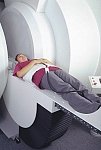 | Info
Sheets |
| | | | | | | | | | | | | | | | | | | | | | | | |
 | Out-
side |
| | | | |
|
| | | | | |  | Searchterm 'Spatial Resolution' was also found in the following services: | | | | |
|  | |  |  | Searchterm 'Spatial Resolution' was also found in the following service: | | | | |
|  |  |
| |
|
| |  | |
• View the DATABASE results for 'Single Shot Technique' (7).
| | | | |  Further Reading: Further Reading: | Basics:
|
|
| |
|  | |  |  |  |
| |
|
Tomography is imaging by sections or sectioning. A device used in tomography is called a tomograph, while the image produced is a tomogram.
The mathematical basis for tomographic imaging was laid down by Johann Radon. It is applied in computed tomography and magnetic resonance tomography (MRT) also called magnetic resonance imaging ( MRI) to obtain cross-sectional images of slices through the body of patients. Each of that slices is defined by thickness and spatial resolution (see voxel). | | | |  | |
• View the DATABASE results for 'Tomographic Imaging' (9).
| | | | |  Further Reading: Further Reading: | | Basics:
|
|
News & More:
| |
| |
|  |  | Searchterm 'Spatial Resolution' was also found in the following services: | | | | |
|  |  |
| |
|



From FONAR Corporation;
in October of 2004, the company changed the product name of the Stand-Up™ MRI to the Upright™ MRI. The Indomitable™, Upright™ MRI is the only open MRI in the world that can perform positional MRI (pMRI), i.e. the Upright MRI™ scans patients in upright, weight-bearing positions, in addition to the conventional lie-down positions. The Upright™ MRI is the only device that can scan patients in the position their symptoms occur, in their position of pain. In early clinical reports independently confirm the effectiveness and potential of positional MRI. In October 2000, Fonar received permission to market the Indomitable™ from the FDA.
Device Information and Specification CLINICAL APPLICATION Whole body -
weight-bearing MRI -
position imaging (flexion, extension, bending, standing, sitting and recumbent scanning)
CONFIGURATION Front-open and Top-open MRIPOWER REQUIREMENTS 380/400/415/440/480 V COOLING SYSTEM TYPE Water, closed-loop | |  | |
• View the DATABASE results for 'Upright™ MRI' (5).
| | |
• View the NEWS results for 'Upright™ MRI' (9).
| | | | |  Further Reading: Further Reading: | Basics:
|
|
News & More:
| |
| |
|  |  | Searchterm 'Spatial Resolution' was also found in the following service: | | | | |
|  |  |
| |
|
| | | |  | |
• View the DATABASE results for 'Volumetric Imaging' (4).
| | |
• View the NEWS results for 'Volumetric Imaging' (1).
| | | | |  Further Reading: Further Reading: | Basics:
|
|
| |
|  | |  |  |
|  | | |
|
| |
 | Look
Ups |
| |